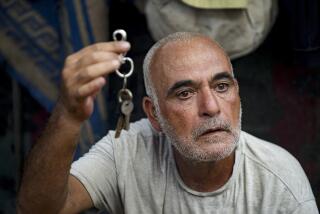Exodus, Genesis : O.C. Cubans Eye Turmoil in Homeland With Fear-- and Hope for Future
For Santa Ana’s Cueto family, the exodus of balseros --rafters--fleeing their native Cuba on flimsy craft has worked its way deep into the fabric of daily living.
*
It is the topic of discussion at every family meal, a point of heated political debate between the elder Cuetos and their grown children, and a pressing reminder of the pain of exile and the deteriorating conditions in the country they still love.
“It has been on our minds constantly,” said Jose Cueto, 69, a retired physician who has lived in Santa Ana since 1968 and has not seen his country since 1959. “My wife and myself, we feel very sad--very sad seeing these people trying to rebel and knowing how brave they have to be there to do that.”
The Cuetos are among the more than 6,000 Cuban Americans who have made Orange County their home for decades, many of them professionals who socialized as youngsters and now organize parties with traditional roasted pig for their own children, hoping to instill in them a love for Cuban culture.
These days, they can speak of little other than the crisis racking the island, debating how the United States government should handle it, pondering plans to invest in the Cuban economy if Castro falls and placing bets on just when that might come to pass.
“I was at a family function a couple of weeks ago and that was what everyone is talking about,” said the Cuetos’ son, Santa Ana attorney Victor Cueto, 35. “Where are you going to open your business or live? Where are you going to build your home? Everybody’s dreaming.”
Political opinions range from those of Victor Cueto, who wants to see the 31-year-old embargo against Cuba lifted, to the more common feelings of people such as Santa Ana businessman Gustavo Aleman, who was imprisoned in Cuba for two years after the failed Bay of Pigs invasion and wants nothing less than to strangle Fidel Castro’s regime.
Aleman, who came to Orange County in 1963 after he was released from prison, fears that Castro will manipulate the talks with the United States government that began Thursday and win concessions that could lead to an end of the embargo.
“I’m skeptical, knowing Castro. I know how he acts and he’s extremely smart--evil but extremely smart,” said Aleman, who owns a Santa Ana injection molding company. “I’m afraid that the dialogue could mean a lifting of the embargo. I know that to talk to Castro you have to promise him something or he won’t even start talking.”
*
Jose Cueto also reserves a special disdain for Castro, his contemporary at the University of Havana in the 1940s.
“For 35 years we have suffered,” he said this week, tapping Castro’s photograph on the cover of Time magazine in his elegantly furnished Santa Ana home.
Cueto said the family’s phone bill has ballooned with calls to Miami in recent weeks to find out more about the situation, and he is considering volunteering to work as a doctor at the refugee encampment in Guantanamo Bay if he is needed.
While he tries to convince son Victor and daughter, Nora Clayton, 41, that the United States should tighten the embargo, Cueto said the thought of his people suffering pains him.
“The letters we got before said nothing about the political situation,” Cueto said. “Now we get letters and they say in big print: Hambre. Hunger.”
Others are more optimistic that some good may grow out of the current havoc.
“I used to have a hope but I thought it was a hope that would never materialize. Now I think Cuba will fall,” said Juan Suarez, 47, who has lived in Santa Ana for 20 years and worked in the aerospace industry. “It’s just a matter of time.”
Suarez left Cuba’s Oriente province in 1962 at age 14 and spent a year in Venezuela before coming to the United States with the help of a settlement plan dubbed Operation Peter Pan.
Last year, he finished a Cuban history course offered by the conservative Cuban American National Foundation. Named “Mission Marti” after Cuban independence poet Jose Marti, the program seeks to educate people about Cuban history from an exile’s perspective and is organizing them according to skills in hopes of reconstructing a capitalist Cuba once the island slips from Castro’s grip.
“I’m looking forward to when we have a new democratic type government there, that I go in and invest in aerospace or the franchising business,” said Suarez.
For all, news of rioting in Cuba earlier this month and the subsequent exodus has inspired a caldron of emotions--hope that collapse is near, anger at Castro, compassion for fellow Cubans on the island, and even fear by some that Castro may send criminals to U.S. shores as he did during the famed 1980 Mariel boat lift.
“I have mixed feelings,” said Rene Moya, 37, who owns a Santa Ana bakery where the walls are adorned with childhood photos of his father’s bakery in Cuba. “On the one hand I’d like to see as many Cubans get out and come in to the United States freely. On the other hand I don’t want to see another Mariel boat lift.”
More than 15,000 Cubans are currently being held at Guantanamo Bay Naval Base, and U.S. officials hope to expand detention camps by week’s end to accommodate 40,000 refugees.
Coast Guard cutters picked up 1,234 migrants in the Florida Straits on Tuesday, a sign that the flood of refuge-seekers that began earlier this month is not abating as U.S. officials had hoped. Large numbers of balseros are reportedly cramming the beaches east of Havana, putting finishing touches on the makeshift boats they hope will carry them to a better future.
“They’re always counting the people who make it here in boats. They fail to count the ones who died at sea, and that hurts. I think about it a lot,” said Frank Palmer, who lives in Villa Park and has had an income tax business with his wife, Maria, in downtown Santa Ana for 17 years.
“It’s almost like the O.J. Simpson trial for us. It’s been very vivid in the news, this whole thing about Cuba right now, which is very fortunate, because it needed some attention,” he said. “Unfortunately it is costing some lives.”
*
Palmer, 45, hasn’t visited Cuba once since he left at age 14 in 1960, and said he wouldn’t “deposit one penny in Castro’s economy.” But the dire situation on the island has triggered fond memories of his birthplace and a longing to take his children there for a visit.
“I wish my children growing up in this country could have the freedoms I experienced growing up in elementary school in Havana,” said Palmer. “It’s my country and I’d like to visit that country some day and see what it was like. I really miss it.”
There are the memories of Cuba’s white sand beaches, the freedom Palmer felt to grab his bike and ride through Havana’s streets knowing he was safe from crime, a friendliness among strangers, and the close-knit ties of extended family that he and Maria must struggle to create for their own two sons here.
And then there are the harsher memories, of Fulgencio Batista’s tanks rumbling up the semi-circular driveway of the Havana Military Academy where Palmer went to school as Castro closed in on Havana.
“I remember going home lying on the seat of the car, when shots were flying,” Palmer said.
Today, Frank and Maria Palmer battle conflicting emotions as they scour newspapers for details of the Cuban crisis and sit glued to television broadcasts of rafters being plucked from rough waters. They even forced their sons, ages 11 and 13, to watch a characteristically long Castro speech on CNN that almost put them all to sleep.
“It just shakes you up. It’s really complex,” said Maria Palmer, 41, who left her native town of Guantanamo in 1964 and estimates that 500 fellow Guantanamo natives live in Orange County. “When you see the babies, it hurts. These are my people. I didn’t come out on a raft, but I came for the same reasons.”
For the whole community, the country’s unraveling serves as a sharp reminder of decades of waiting.
“My father was very patriotic. He was always thinking of Cuba,” Frank Palmer said. “We didn’t buy a house in the United States until many years after we were here. He was always thinking that next week we would go back, and next week and next week. Unfortunately, that never happened. He’s been dead now two years.”
More to Read
Sign up for Essential California
The most important California stories and recommendations in your inbox every morning.
You may occasionally receive promotional content from the Los Angeles Times.











